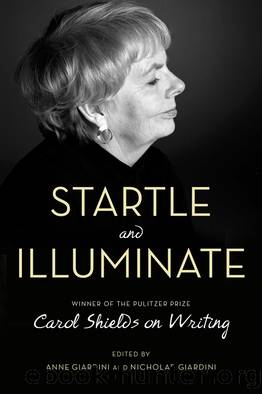Startle and Illuminate: Carol Shields on Writing by Carol Shields

Author:Carol Shields [Shields, Carol]
Language: eng
Format: epub
Tags: Canadian, Composition & Creative Writing, Language Arts & Disciplines, Literary Collections, Non-Fiction
ISBN: 9780345815965
Google: dnRpCgAAQBAJ
Publisher: Random House of Canada
Published: 2016-04-25T23:00:00+00:00
In Brief …
The crucial elements:
• Story: A story is about moving from one state to another, a movement that may be psychological, involving a growth of awareness that comes in a series of revelations.
• Tension: The simple bonding of one’s self to one’s writing can create tension, that sense of urgency that underlies certain books, a feeling that this story is being told because it has to be told.
• Pacing: Pacing involves the selection and placement and timing of the variables of the story, the way in which the story is unrolled for the reader, the manner in which it moves from revelation to revelation. An important part of pacing is releasing pertinent information at exactly the right moment; too much at one time can make the reader feel force-fed. Pacing can be controlled to some extent by the skilled use of breaks.
• Framing: Framing is often unnecessary; it can bury or muffle a story. It can be easy to edit out the framing—a simple cutting of the first and last paragraphs.
• Cutting: The right detail in the right place can linger long after the story is forgotten. But cutting extraneous detail can tidy a story and increase its pace, and can also change its nature.
• Dialogue: Dialogue provides a sense of place and time. It reveals character, moves the story forward, and provides information we need that would sound self-conscious in the narrator’s mouth.
• Scenes: One of the most persistent problems in fiction is the failure to understand that a story is made up of scenes. Scenes have to be more than a fleeting image. They have to be solidly built and furnished. They have to be introduced, allowed to develop and conclude in such a way that the next scene is prepared for. Sustain a scene for as long as it is still level, inventive, beguiling and yielding answers to what this story is about. Scenes help the story fall into manageable units. A scene at a time; a step at a time.
• Transformation: A story is fiction and not autobiography because an act of transformation has taken place. Sometimes this involves relocation, renaming or reshaping or, most importantly, reinterpretation and re-imagining.
• Time: It is difficult to handle time in fiction. Interesting and complex time structures occur in almost all serious fiction, but a good idea for beginning writers is to set your works in manageable time chunks. Past action must be carefully introduced and not allowed to swallow up a disproportionate part of the story.
• Opening sentences: Opening sentences take you into the story, push at the future and nudge your expectations, setting the tone and carrying you over that threshold into the fictional world. These sentences work best when they carry an implied question.
• Climax: You probably do need one major event or confrontation—this need not be a physical upheaval; it can be an unfolding of understanding. Some planning must go into generating this scene—a number of smaller scenes may build toward it, some foreshadowing, little
Download
This site does not store any files on its server. We only index and link to content provided by other sites. Please contact the content providers to delete copyright contents if any and email us, we'll remove relevant links or contents immediately.
| African | Asian |
| Australia & Oceania | Canadian |
| Caribbean & Latin American | European |
| Jewish | Middle Eastern |
| Russian |
The Hating Game by Sally Thorne(17478)
The Universe of Us by Lang Leav(14367)
Sad Girls by Lang Leav(13351)
The Lover by Duras Marguerite(7115)
Smoke & Mirrors by Michael Faudet(5508)
The Rosie Project by Graeme Simsion(5189)
The Shadow Of The Wind by Carlos Ruiz Zafón(4939)
Big Little Lies by Liane Moriarty(4880)
The Poppy War by R. F. Kuang(4431)
Memories by Lang Leav(4171)
What Alice Forgot by Liane Moriarty(3918)
An Echo of Things to Come by James Islington(3839)
From Sand and Ash by Amy Harmon(3679)
The Poetry of Pablo Neruda by Pablo Neruda(3367)
The Tattooist of Auschwitz by Heather Morris(3250)
Guild Hunters Novels 1-4 by Nalini Singh(2933)
Ficciones by Jorge Luis Borges(2860)
THE ONE YOU CANNOT HAVE by Shenoy Preeti(2826)
The Rosie Effect by Graeme Simsion(2708)
